#t dohrnii
Explore tagged Tumblr posts
Text

a handful of mercreatures
#not silm#art#i should have a tag for original art huh#original art#character art#character design#mermaid#merfolk#volcano snail#scaly foot gastropod#ribbon worm#t dohrnii#turritopsis dohrnii#blue glaucus#e chlorotica#elysia chlorotica#nudibranch#i should do some more mernudibranches sometime#needed to get some creativity flowing for a comm and turns out drawing random colorful critters helps with that
34 notes
·
View notes
Text
A TREATISE ON WINGS, IN NON-WINGED CREATURES
IF a person were to have wings. the automatic problem with making them avian stylistically is that wings are homologous to human forelimbs. wings are forelimbs. ergo: why people get so mad about dragon designs that showcase four limbs AND wings, because the majority of the time they’re intended to be close to reptiles (tetrapod lineage). likewise, any sort of mammalian basis (bats) also fails*. there is an interesting potential to gain some characteristics that would indicate conversion of forelimbs into wing-like structures but would not be practical because i am setting this in a universe where we need. y’know. hands**. HOWEVER. in the interest of i need to create a functional justifiable mechanic to write (porn. i would love to lie but the odds are really good it's just pwp), i really like the idea of using an insect analog***.
first at bat to narrow down our options: direct or indirect flight. for the sake of limiting the amount of internal bodily anatomy this transformation would have to result in, i think direct flight (sheer muscular willpower to raise and lower wings) works best as a mechanic. in theory, (based on these human anatomy diagrams) the massive elevator and depressor muscles that insects with direct flight use can be loosely translated to a really well developed transversus thoracis (depressor of the rib cage) and potentially pectoralis/levator scapulae. it’s not an elegant method of flight but it does = flight. also, because this method of flight is so stupid and silly, i have fewer options to play with. i think it does fit in this context that of course it would be flight by brute force instead of finesse.
next: how are we getting these wings. my immediate thought goes to hox genes being activated**** and T2 segments. oh did you want smooth shoulders and vertebrae? too bad. extra limbs***** and in particular, ubx (a specific cluster) mutations are famous for resulting in flies with extra wings. ubx would be a good candidate for activation if we can find a similar cluster that is conserved in humans******. really, any gene cluster associated with the development of wings being activated here helps.
[hox genes interlude, tl;dr our body starts as “segments” that are programmed to become different tissues/areas/structures. hox genes = architects of body design at a broad scale, activate other genes for differentiation of radius, humerus, carpus, etc. therefore: major body change, such as adding an entire limb = i’m arguing hox genes involved. what we want to do is the same as those mutant bugs: mutate the T3 segment (vertebrae between shoulder blades in humans -> end of thorax in insects) to be similar to “T2” (site coding for insect wings) using hoxa&d 5/6/9-13::homC to tell it what to do, and you should get another limb. wings, if we fiddle with the genetics. which, given that hox genes are pretty much preserved, i'm sure we could find an ultrabithorax to turn on.]
so we’ve kind of got wings, in an embryonic sense, or at least the mechanism for them. how do we make this happen “spontaneously”? can we generate a series of events that will trigger gene activation and phenotypic change? i mean. yeah arguably. i think the argument becomes whether the activation of our imaginary gene occurs via phenotypic plasticity, local adaptation, or environmental epigenetics*******. in any case, the key fact is that the environment******** leads to an altered phenotype via gene expression and voilà: wings.
ok but girl WHAT are these wings made of??? oh i'm so glad you asked. per our insect friends and also mammals -> mesenchymal stem cells, which adult hox genes code for, and these "buds" can be shaped into wing-like structures according to highly debated insect development (see footnotes). which means: we can have bone. and muscle and cartilage and fat, if we have something to trigger that differentiation, which we just said we can. and what's from stopping our mesenchymal cells from differentiating into keratinocytes? literally nothing. they do it all the time. so... what are feathers made of? keratin. arranged particularly. and in the most enormous handwave i have done in this entire thing, all of the multiple genes i've said "yeah they probably exist and we can have them"********* allow for that keratin to be arranged in a way that makes feathers and that bone and muscle in a way that makes wings. really the only part that will take work is building up those elevator and depressor muscles, but with the growth of the wings it shouldn't be too bad.
and in the end we have circled RIGHT back around to the complete opposite point, which is what i have been arguing towards the whole time: bird wings are plausible if we consider a lot of things that are not birds, like bugs**********. happy wing-ficc’ing!!!
FOOTNOTES (unumbered because tumblr can’t superscript)
*for the sake of horny, i am ignoring this and adding some avian characteristics because a) that’s what people expect when you write wing fic, b) uropygial gland is a major plot point, and c) bird erogenous zones enough said.
**a baseline assumption here when prompted with “wing fic” to me is that there should be wings in addition to arms, because most people do not feel morally conflicted about inaccurately portraying the biology of wings because: THAT’S NOT THE POINT or it is accepted within their universe to have these rules (angels, etc). alas. you’re in the torture realm with me and i’m inventing the rules. if this were purely for myself i think it would be much easier and plausible to myself oops! keratin the epidermis and replace hair with feathers or to “evolve” arms into wings or a multitude of alternative biologies (the breakdown about wing possibilities would be another post). but again: we need hands to play hockey and we want full on wings, so here we are.
***insect wings are not limbs!! problem solved!! this also has nothing to do with my love for invertebrates and secretly something to do with botany and also some really big imaginative stretches. i am making all of this up, except for the parts where i have citations.
****i KNOW they teach you hox genes are active only in skeletal development in embryo. see rux & wellik 2017 for studies on expression in adults. if they can aid in expression of mesenchymal stem cells and bone repair i see lots of possibility for new bone growth but we’ll get there.
*****they did a study where they basically did this. insect hox segmentation has antennapedia clusters that control the placement of antennas vs mandibles vs limbs; alter these genes and you get a bug that is baller at heading soccer balls.
******this is a brief aside to say that there are hella arguments about the evo-devo of insect wings despite agreements that it is monophyletic. for the sake of my desired result (fully formed outgrowths of bony wings) i am favoring the idea of the pleural/exite hypothesis or dual origin. don’t ask me to get more specific about the genes i think we’re already pushing it if i co-opt and terribly vague the idea of exites/somites to explain the process of wing growth via “budding”.
*******we really don't need to worry about this, which is why it's going in a footnote that this is kind of a chicken and egg situation where we're not quite sure why phenotype can change in response to the environment with no genome change but people think that environmental epigenetics (influence of chemicals, etc on genome that alter expression/how well genes can be transcribed) may be how phenotypes change. not the same thing; EE -> PP, perhaps, but also perhaps there's some other mechanism.
+ for another side note, i love epigenetics because they're dope as hell and epigenetics are heritable, which could be fun. local adaptation is just there because it is a possibility--given the insular nature of hockey we could see this (founder effect? drift? stress?), although because it's a genetic shift it requires much more Lineage and Generations to things. no single generations here we're not bacteria!!! again, with the wing alternatives paper i am not writing, it would be interesting to see pathways of evolution in different populations and who could be a local adaptation vs phenotypic plasticity.
********normally this would be literally anything like diet or toxins or exercise etc etc etc. behavioral epigenetics is also really cool and i linked a paper (creighton et al 2020). anyway for purposes of the alleged wing fic i have managed to write ??? about without actually writing, we have an environmental trigger in the form of hockey but i am debating a horny trigger. for funsies. like horny weird puberty :) which if i'd gone THAT route--*comedy hook yanked off the stage*.
*********listen, evolution loves to say heyyyy what if i saved that for laterrrr and simply does not get rid of like anything. she just turns it off. don't make me pull out the phylogenetic tree We Were All Fish once and your genes remember. Shh differentiates scales/claws/hair. we could have feathers if we wanted.
**********also don't look at how much of this is secretly plants and not even insects. but do look at all the citations if you want. if you read all that i love you thanks for coming to my ted talk <3
REFERENCES (kind of in order. no direct citations because we treat footnotes like a joke #boochicago and also i can't be bothered to do apa or mla in text we are clowning on every format. you can maybe have afs if you really want it)
Rux, D. R., & Wellik, D. M. (2017). Hox genes in the adult skeleton: Novel functions beyond embryonic development. Developmental Dynamics, 246(4), 310–317. https://doi.org/10.1002/dvdy.24482
Tomoyasu, Y. (2017). Ultrabithorax and the evolution of insect forewing/hindwing differentiation. Current Opinion in Insect Science, 19, 8–15. https://doi.org/10.1016/j.cois.2016.10.007
Holland, P. W., Booth, H. A., & Bruford, E. A. (2007). Classification and nomenclature of all human homeobox genes. BMC Biology, 5(1). https://doi.org/10.1186/1741-7007-5-47
Clark-Hachtel, C. M., & Tomoyasu, Y. (2016). Exploring the origin of Insect Wings from an Evo-Devo perspective. Current Opinion in Insect Science, 13, 77–85. https://doi.org/10.1016/j.cois.2015.12.005
Frischer, L. E., Hagen, F. S., & Garber, R. L. (1986). An inversion that disrupts the antennapedia gene causes abnormal structure and localization of RNAS. Cell, 47(6), 1017–1023. https://doi.org/10.1016/0092-8674(86)90816-0
Nelson, C. E., Morgan, B. A., Burke, A. C., Laufer, E., DiMambro, E., Murtaugh, L. C., Gonzales, E., Tessarollo, L., Parada, L. F., & Tabin, C. (1996). Analysis of Hox gene expression in the chick limb bud. Development, 122(5), 1449–1466. https://doi.org/10.1242/dev.122.5.1449
Zhang, B., He, P., Lawrence, J. E., Wang, S., Tuck, E., Williams, B. A., Roberts, K., Kleshchevnikov, V., Mamanova, L., Bolt, L., Polanski, K., Li, T., Elmentaite, R., Fasouli, E. S., Prete, M., He, X., Yayon, N., Fu, Y., Yang, H., … Teichmann, S. A. (2023). A human embryonic limb cell atlas resolved in space and time. Nature, 635(8039), 668–678. https://doi.org/10.1038/s41586-023-06806-x
Romero-Mujalli, D., Fuchs, L. I., Haase, M., Hildebrandt, J.-P., Weissing, F. J., & Revilla, T. A. (2024). Emergence of phenotypic plasticity through epigenetic mechanisms. Evolution Letters, 8(4), 561–574. https://doi.org/10.1093/evlett/qrae012
Gao, S., Mo, L., Zhang, L., Zhang, J., Wu, J., Wang, J., Zhao, N., & Gao, Y. (2018). Phenotypic plasticity vs. local adaptation in quantitative traits differences of Stipa grandis in semi-arid steppe, China. Scientific Reports, 8(1). https://doi.org/10.1038/s41598-018-21557-w
Dar, F. A., Mushtaq, N. U., Saleem, S., Rehman, R. U., Dar, T. U., & Hakeem, K. R. (2022). Role of epigenetics in modulating phenotypic plasticity against abiotic stresses in plants. International Journal of Genomics, 2022, 1–13. https://doi.org/10.1155/2022/1092894
Duncan, E. J., Gluckman, P. D., & Dearden, P. K. (2014). Epigenetics, plasticity, and evolution: How do we link epigenetic change to phenotype? Journal of Experimental Zoology Part B: Molecular and Developmental Evolution, 322(4), 208–220. https://doi.org/10.1002/jez.b.22571
Kelly, S. A., Panhuis, T. M., & Stoehr, A. M. (2012). Phenotypic plasticity: Molecular mechanisms and adaptive significance. Comprehensive Physiology, 1417–1439. https://doi.org/10.1002/cphy.c110008
Eckhart, L., Valle, L. D., Jaeger, K., Ballaun, C., Szabo, S., Nardi, A., Buchberger, M., Hermann, M., Alibardi, L., & Tschachler, E. (2008). Identification of reptilian genes encoding hair keratin-like proteins suggests a new scenario for the evolutionary origin of hair. Proceedings of the National Academy of Sciences, 105(47), 18419–18423. https://doi.org/10.1073/pnas.0805154105
Liu, Y., Edgecombe, G. D., Schmidt, M., Bond, A. D., Melzer, R. R., Zhai, D., Mai, H., Zhang, M., & Hou, X. (2021). Exites in Cambrian arthropods and homology of arthropod limb branches. Nature Communications, 12(1). https://doi.org/10.1038/s41467-021-24918-8
Creighton, S. D., Stefanelli, G., Reda, A., & Zovkic, I. B. (2020). Epigenetic mechanisms of learning and memory: Implications for aging. International Journal of Molecular Sciences, 21(18), 6918. https://doi.org/10.3390/ijms21186918
#WORLD’S BIGGEST DISCLAIMER I AM NOT AN ENTOMOLOGIST!!! sorry if you are i did my best!!!!!!#i am ALSO not a geneticist. or like. an ornithologist. i do however have a BS degree#(legitimate) (also a joke that this should be taken with a grain of salt)#liv in the replies#this may become privated due to: who is reading all that and linked when i have to add the a/n of I KNOW BUT to appease my brain#and now you are asking me liv why did you not simply talk about abscission or axolotl limb regrowth or—LISTEN. limb regrowth =/= new limb.#this is already at a length that is unreasonable but i am hoping this cures the nonsense in my brain that was like#YOU CAN’T WRITE LENO GETTING DICKED DOWN BY PLD UNLESS YOU HAVE THE STIPULATIONS OF HOW HE ACQUIRED WINGS#and i realize that the answer that makes the most sense and that i would be pleased to read in someone else’s fic is simply. magic.#but alas. what do you get a degree for if not to write highly questionable discussions of how you could get wings on a tetrapod#to which my answer is bro look at bugs those aren’t limbs. but then make them limbs.#also they’re not tetrapods.#sorry?#this is in the vein of one day i will finally decode that note about age regression fic premise from t. dohrnii & medusae vs polyp forms#also like. all of the time i am writing this the you i am arguing with is myself. everyone else is fine & beloved EYE am the problem
4 notes
·
View notes
Text
Me: Aw, my ideas for ectonurite reproduction are unrealistic, good thing I can use magic and the presence of Anodyne to justify them!
The humble turritopsis dohrnii: Let me introduce myself
So, after bumbling the idea of how the freak ghosts would produce more of themselves, I can now use an actual real world base to actually understand how the mechanisms would work.
Even though I've linked where I found out about the aptly named 'immortal jellyfish' I'm not going to expect anyone to read it, especially since it's pretty dry as more of a scientific debrief on the life-after-adulthood cycle of the t. dohrnii, but to summarise; outside of the standard reproductive cycle, a 'reverse development' would start in the medusa stage (essentially the adult stage but both mature and immature medusae can reverse develop), transition to a ball-like cyst stage where their features disappear, then metamorphizse back into a polyp where it would then reenter the standard reproductive cycle by developing from a bud to an adult polyp again to reproduce asexually, creating medusae once again. It's not quite as extreme as to say it reverses it's mitosis, simply that the transition to becoming a cyst allows for the cells to metamorphose and reattach themselves to the sea floor as a polyp, a 'hydroid colony' with reproductive zooids (something about 'fulmini = siphonophore' post).
Anyway! That's the general gist and I wanna go ahead and apply that to ectonurite AND expand on how it'd define their culture, not just being genetically immortal but also how the different life stages interact socially.
One thing I didn't mention in the summary but will use as an introduction to this section is that a precursor to the reverse development process is a 'weakened' state, which aside from the slow natural degradation of aging and a more controllable but also slow deterioration from the environment (faster if the environment is at least slightly harmful), also includes physical damage. I know I haven't made a whole post about this before but I think I might've implied in other topics that ectonurites need to die in order to reproduce, but I suppose 'dying' is now less literal as it's more the cells work overtime to heal from whatever physical issue put the individual into their state, doing so by morphing them into what amounts as scar tissue; a cyst. A lesion, a wound, a scab. Something that will in it's own right metamorphose yet repair in it's own right, become something new directly from the old.
An ectonurite medusa, the main body beneath the skin, would undergo the process of reverse development and become a cyst, the skin it's new cocoon yet also it's sail, leading the pulsing core of the cyst where whatever winds will take it. It will eventually make landfall, whether it was lead by the environment or nurtured by observing family - siblings and cousins and auncles but no parents, parents are impossible to have - and it would begin to metamorphose using the skin as nutrients and begin the steps again to become a polyp, a sprouting flower. Wherever they had landed they have become something new, and will continue to develop into being that something new until they create themselves once again, being born of their own body and creating more than they had ever been alone. From one into a myriad, the budding of the polyp creates more of themself and though in large quantity, the mortality rate is quite frighteningly significant. However when all is said and done, the asexual reproduction of the polyp spawns new descendants of the original medusa, in clutches of 5-20 on average; some more... some less.
Ectonurite spawn are still affected by their anti-mana life force, in reaction to the intersection between the planes allowing Anodyne and Lederdomain influences to spread amongst Anur Phaetos, so no matter where they end up budding they still take on the traits and attributes of the life around them like a sun-hungry plant. Technically fully mature medusa are also affected by this but it occurs less due to their final state, it is the cyst that initially begins to integrate the medusa's external influences into it's genetics, which in turn it uses in it's metamorphosis including the older genes present in the skin. Sisters Zs'Iza and Zs'Oise are an example of such with their visibly transylian faces in addition to their skin having the bandaged texture of thep khufan's many limbs. They are also an example of the 'less than average' clutch size a polyp can develop, a scorn say a power-hungry High Ecto-lord cannot bare to face, let alone acknowledge that it was amongst his genetics to barely remain biologically immortal.
AKA the reason why Zs'Skayr held interest in the Omnitrix, preservation of his genetics in a way that his species could even compare to even as close as they try. Something about desiring something more when it is just out of reach instead of being completely unattainable, immortality an easy concept to grasp when it is not hard to deride reincarnation from ones own natural biology. Especially since with the technology of the Omnitrix inherently blocking the influence of mana and thus rendering Zs'Skayr completely himself without the genetic differences of the life around him.
Speaking of the High Ecto-lord (a dumb name I'll give it the benefit of a mistranslation of a Phaetan or even a general Anurian term into English to cope with it), politically with their reproduction in mind I can see it in two ways; an absolute monarchy where the High Ecto-lord passes the role to their next life or something like a post-constitutional monarchy (emphasis on post-monarchy) where ectonurites have biological knowledge to know that appointing the one literal same guy over an over again with absolute power is bullshit but they recognise them as a figurehead with a political force of chosen reps behind them. Having a preference for the second, I'll say that Zs'Skayr is extra motivated to figure out actual immortality of the self in order to retain what little rule he does have, especially if with his clutch sibling only ending up producing two young with no other family of his in Zs'Castle Zs'Skayr to speak for, it seems he is at the end of his rope and wants to cling onto that for as long as infeasibly possible.
Moving on and hah, reverse developing this discussion to an earlier point, let's go back to ectonurite cysts and expand what I mean by 'observing family'.
Ectonurites, though biologically immortal, do host something equivalent to that of a funeral. However, unlike most funerals where the person who's the main event OF the funeral is very much dead and lacking any agency over the event, ectonurites old significant age or those with a significant amount of physical damage host their own funeral; in some cases, either immature medusae who's current combination of genes have given them rapid cell death and accelerated aging, or someone is significantly injured they cannot do much anything else, a funeral is hosted for them. It's an event that simultaneously mourns the old and celebrates the new, where during the middle of the funeral the host instigates their reverse development (or it's instigated for them) and the procedure from medusa to cyst to polyp takes place. These events often take place outside, but if the atmosphere is thick enough and there are no land-locked species in attendance then they might take place in the air itself, if not the full event where maybe the host wants a feast or activities before they reverse then in the reversal itself. This is done to make sure the cyst has ample time to drift to be coerced into drifting into a spot they and the family agreed upon away from the event space, more often than not directed to a family garden or a community garden, but sometimes in spots the host specifically wished to drift to or even through chance alone.
This can have a few Karen moments treated similarly to the way say human mother-in-laws demand full creative control over their children's wedding or guests that want all the attention come wearing white to the very same, but applied to what is essentially simultaneously funerary rights and also a baby-shower hah. The Tr'Riken moment perhaps for family name given name *pans over to me scrabbling to piece together a Phaetan equivalent name to Karen* maybe Pani'Kn or given name family name, who knows.
And with funerals being as casual conversation as humans consider weddings to be, sometimes some auncles siblings and cousins like to push the idea of their family member hosting a funeral someday, especially since unlike marriage it's a pretty guaranteed thing to happen. Sometimes though family would pester ectonurites with benign or otherwise non-terminal diseases illnesses or disabilities with arranging funerals because 'well, this combination of genes hasn't really worked out for you, but if you spend time with [xyz] and host one maybe you could get a different pattern and avoid all that'.
What I haven't mentioned yet is the family and community gardens. Gardens of polyps that either live on family property or exist in lots where housing and or hospitals are close by. When one says biologically immortal one might assume that the polyps that produce their youth asexually would be also immortal and thus outgrow any physical lot, but that is untrue. Instead, though the polyps last much longer than a corpse would in addition to being around longer with maintenance of the family or community gardeners, they are not immune to dying of old age. Since polyps are not the reverse developing medusae they cannot themselves persist in life beyond death and just like all polyps do eventually come to pass. Unlike a funeral perhaps where there is a person to actively mourn however, the passing of a polyp is seen as beautiful. The medusae produced by the polyp have legal rights on what to do with the remains of functionally their earlier self, whether to perserve it like a flower crushed within the pages of a book (though much more elegantly than that), to seal it in some resin as the equivalent of an urn (a display piece that does not decay), or to let it 'metamorphose' one last time an let it feed the grounds of the garden it lived in.
Zs'Castle Zs'Skayr's entrance was guarded by pumpkins yes? Like a form of garden right? I wonder what happened to all the Zs' family's polyps *blinks innocently*?
#ectonurite#zs'skayr#ben 10#xenobiology#yippie yippie yippie shout out to the goat (not a goat) turritopsis dohrnii) yippie yippie yippie#i think jarred my fingers they are sore woospies#should i tag my main man? i mentioned him i guess#dot you cry why did you mention transylians and thep khufan if you removed them from your magic and mutants au#did i say i removed them? i just said i changed even the classic series to be more magic and mutant#i may not have actually made the distinction between transylians vs dr viktor and thep khufan vs the mummy#beyond the fact that dr viktor would be mutant and the mummy would be magic that also affects my mummy oc kesi#but that doesn't necessarily remove transylians and thep khufan from this ocverse i shove all my headcanons into#just means at some stage they'll be a lot more alien than one might recall them being#since loboans are like the easiest alien to understand BEING an alien even if human media werewolves are shapeshifters and loboan are not#well- unless you accidentally dyslexia yourself into spelling lenopan but that's like the origin for another oc of mine
12 notes
·
View notes
Text
Keeping T. dohrnii in captivity is quite difficult. Currently, only one scientist, Shin Kubota from Kyoto University, has managed to sustain a group of these jellyfish for a prolonged period of time. The plankton must be inspected daily to ensure that they have properly digested the Artemia cysts they are being fed.[5] Kubota reported that during a two-year period, his colony rebirthed itself 11 times.[32] Kubota regularly appears on Japanese television to talk about his immortal jellyfish and has recorded several songs about them, often singing them at the end of his conference presentations.[5][33]
4 notes
·
View notes
Text
Weird Creature of the Day: Immortal jellyfish
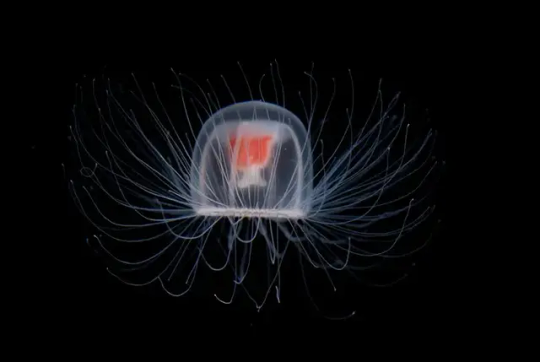
No, the name isn't poetic. Here's Turritopsis dohrnii.
So what does that mean, exactly? The word "immortal" is used in biology to indicate when an organism's cells don't hit Hayflick limit- the point where they can't divide into daughter cells because of DNA damage and/or shortened telomeres. We don't fully understand all the elements at play here, as science is still trying to crack the "formula" for aging and what starts/stops it. This little guy gives us an interesting glimpse at some possible mechanisms at play in all the eukaryotic species out there (like us!).
It is so teeny tiny. They only reach about 4.5mm (less than a 5th of an inch) at full size. That's like the size of the nail on your little finger. So itsy bitsy teeny weeny.
First documented in the 1880s in the Mediterranean, T. dohrnii start out as larvae called planula. The planula then turns into a polyp colony on the sea floor. These polyps develop into the adult medusa stage AKA the jellyfish shape we all recognize (AND LOVE)
When injured or malnourished, an adult can revert back to the polyp stage and start over again. The new adult medusae are genetically identical to the original adult. This isn't the same as asexual reprduction like you see with ferns or hydras. Immortal jellyfish grow to sexual maturity and reproduce via fertilizing eggs with sperm. But they can revert to a sexually immature stage after already reaching sexual maturity. They're the only animal species we know of that can do that!
Okay, but how the hell do their cells pull it off? It's a rare process called transdifferentiation. You know how stem cells eventually develop into different specialized tissues for various purposes? Transdifferentiation turns already specialized cells- typically a permanent situation- into other types of specialized cells. It's very efficient for recycling cells/cell matter. Scientists are researching this mechanism and its implications for the world of medicine. The development of medical applications for this is still in its infancy, but in lab studies, artificially induced transdifferentiation has turned mice liver cells into beta cells (and then we did the human equivalent), and certain mice ovary cells into teste cells. Perhaps in a few hundred years, medical transition options could include performing literal alchemy on your gametes to home-grow your own HRT. It's wild to think about the implications of this.
A scientist at Kyoto university, Shin Kubota, kept a T. dohrnii colony under study for several years. He reported that during a two-year period, his colony rebirthed itself 11 times.
The immortal jellyfish is depicted (very adorably) in the 2020 Halloween Google Doodle as one of the bosses you fight. Legitimately one of my favorite games, check it out!
Photo: Takashi Murai/The New York Times Syndicate/Redux
#marine biology#Jellyfish#wcf#weird creature feed#wcotd#weird creature of the day#Marine Wildlife#Where is my sci-fi about high tech alchemical transmutation transgenderism#I'm going to be thinking about this all day#cohost archive
3 notes
·
View notes
Text
Blog 9: The Immortal Jellyfish
Nature is full of wonders, but few are as astonishing as the tiny yet extraordinary Turritopsis dohrnii, known as the "immortal jellyfish." This hydrozoan defies aging through transdifferentiation, reverting its adult form back into a juvenile polyp when stressed or injured (Britannica, n.d.). Instead of dying, it restarts its life cycle, potentially living indefinitely. This remarkable ability has captivated scientists exploring the limits of aging and regeneration (Miglietta, n.d.).
At just 4.5 mm across, T. dohrnii appears delicate, with a bright red stomach and up to 90 thin, trailing tentacles. Originally from the Mediterranean, it now thrives in coastal waters worldwide (American Museum of Natural History [AMNH], 2019). Unlike most jellyfish, it can rewind its biological clock in response to environmental stress (Miglietta, n.d.).

(American Museum of Natural History [AMNH], n.d.)
This adaptation is linked to genetic mechanisms that enhance DNA repair, stress resistance, and telomere maintenance—factors also relevant to human longevity research (AMNH, 2019). However, studying T. dohrnii is challenging due to its small size and sporadic populations, often disappearing after sudden spikes in abundance (Miglietta, n.d.). Despite these difficulties, ongoing research continues to reveal its secrets.
Interpretation: Bridging Science and Public Curiosity
As nature interpreters, we transform complex discoveries like T. dohrnii into engaging narratives. Most people will never see an immortal jellyfish, but through storytelling, digital media, and interactive experiences, we can share this wonder with people everywhere. Embracing technology is crucial in making scientific knowledge more accessible (Beck et al., 2018). Social media, websites, and interactive exhibits can bridge the gap between research and public understanding, fostering a deeper appreciation for nature.
The role of interpretation extends beyond simply relaying information; it inspires curiosity, connection, and conservation. The story of T. dohrnii challenges our understanding of life and death, pushing the boundaries of what we thought possible. By integrating digital tools, we can make these astonishing facts more accessible, ensuring that even those far from the ocean can still be mesmerized by its mysteries (Beck et al., 2018).
Moreover, interpretation should not be confined to museums and parks but incorporated into everyday experiences. Cultural tours, informative plaques, and digital storytelling provide immersive ways for people to engage with nature. This approach fosters a more informed and environmentally conscious society, encouraging individuals to take action in preserving our natural world.
Interpretation is also a powerful tool in tourism, contributing to community education and sustainability. By providing engaging content about species like T. dohrnii, interpreters create meaningful experiences that inspire further exploration and conservation efforts. Local communities benefit when visitors gain a deeper appreciation for the natural environment, leading to responsible tourism and increased interest in preserving fragile ecosystems.
The story of Turritopsis dohrnii reminds us of nature’s boundless potential. As interpreters, we bridge the gap between scientific discovery and public understanding, ensuring that incredible stories like this reach people everywhere. Through interpretation, we invite others into the intricate and breathtaking world of nature, one discovery at a time.
References
American Museum of Natural History. (2019). The immortal jellyfish: A natural wonder. Retrieved from https://www.amnh.org/explore/news-blogs/immortal-jellyfish
Beck, L., Cable, T., & Knudson, D. (2018). The bright future of interpretation: Trends, issues, and opportunities. Sagamore Publishing.
Britannica. (n.d.). Immortality. Retrieved from https://www.britannica.com/topic/immortality
Miglietta, M. P. (n.d.). Research on immortal jellyfish and gelatinous zooplankton. Texas A&M University. Retrieved from https://www.tamug.edu/miglietta/Research.html#:~:text=fluctuations%20of%20gelatinous%20zooplankton%20are,to%20start%20a%20long%20term
0 notes
Text
Most Amazing Thing About Nature - Blog Post 8
To pick the most amazing thing I know about nature is a very hard thing to do! There are so many beautiful parts of nature that deserve to be talked about, that it’s difficult to settle on only one. The amazon rainforest, and it’s ability to stabilize the earth’s climate (Flores, et al., 2023), the northern lights and how charged particles colliding with the gases of the upper atmosphere causes flashing lights in the sky (Government of Canada, 2024), and many more natural phenomena are fascinating to learn about.
For this blog post, I am going to talk about a tiny creature that is basically immortal; the Turritopsis dohrnii, also known as the Immortal Jellyfish. Imagine being able to reset your age whenever you need to, never having to worry about growing old.

This jellyfish is able to do that! They are found in the Mediterranean, and are around 4.5 mm in size, which is around the size of a pinky fingernail (AMNH, 2015). They avoid death by transforming backwards, from an adult to an adolescent, which “debunk(s) the most fundamental law of the natural world- you are born, and then you die.” It is like a caterpillar turning into a butterfly, but instead of dying, it turns back into a caterpillar! In this case, the jellyfish turns back into a polyp (Rich, 2012).
The reason why the Turritopsis dohrnii is able to do this, is due to a cellular mechanism called transdifferentiation. It is a rare process, where the mature cell can directly convert into another cell, without completely needing to turn into a fertilized egg (AMNH, 2015). It's basically restarting.
Comparing it to the pluripotent stem cells in humans, which are cells that can turn into almost any tissue, it would be amazing if our bodies could react like this jellyfish does. We could heal our injuries much faster, fix any missing limbs, maybe even slow down our aging. Even with these shocking facts, the Turritopsis dohrnii is still very unknown to most people, compared to other sea animals such as whales and sharks. Although it does not receive the same level of attention, our ideas of life and death are questioned when it comes to the existence of this jellyfish. The rules of life and nature are broken, and by an animal the size of my fingernail!
It makes me wonder what other creatures have “superpowers” like this, which we don’t know of. The ocean is filled with mysteries, as we have only seen 5% of it. There may be all kinds of hidden abilities in there that can make us question what we know about nature.
Referring to the textbook's teachings of a nature interpreter, the authors talk about how an interpretor isn't just for sharing nature facts, but to show the meaning behind the wonders of nature. With this jellyfish, not only does it outlive death to a certain extent, but it shows us that life isn’t always a perfect linear path. Starting over is also a part of life too, and it’s okay to take a step back and restart whenever you need to. This is a symbol that I would take away from the discovery of the Turritopsis dohrnii. Life is filled with second chances, and this jellyfish happens to have it's second chances physically displayed to us, as a resurrection back to life. Although we don't have this ability ourselves, we still encounter changes in other ways.
If humans had the same ability as the Turritopsis dohrnii, and be able to reset our age, would you want to? Why or why not? And do you think research should focus more on living a longer life or a healthier life?
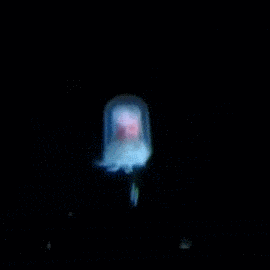
The way the jellyfish swims is just so cute!
References
American Museum of Natural History. (2015). The Immortal Jellyfish. https://www.amnh.org/explore/news-blogs/immortal-jellyfish
Beck, L., Cable, T. T., & Knudson, D. M. (2018). Interpreting cultural and natural heritage for a better world. Sagamore-Venture.
Government of Canada (2024). What are the northern lights? Canadian Space Agency. https://www.asc-csa.gc.ca/eng/astronomy/northern-lights/what-are-northern-lights.asp
Flores, B. M., Montoya, E., Sakschewski, B., Nascimento, N., Staal, A., Betts, R. A., Levis, C., Lapola, D. M., Esquível-Muelbert, A., Jakovac, C., Nobre, C. A., Oliveira, R. S., Borma, L. S., Nian, D., Boers, N., Hecht, S. B., ter Steege, H., Arieira, J., Lucas, I. L., Berenguer, E., Marengo, J. A., Gatti, L. V., Mattos, C. R. C., & Hirota, M. (2023). Critical transitions in the Amazon forest system. Nature. https://www.nature.com/articles/s41586-023-06970-0
Rich, N. (2012). Can a Jellyfish Unlock the Secret of Immortality? Center for Biological Diversity. https://www.biologicaldiversity.org/news/center/articles/2012/new-york-times-11-28-2012.html
0 notes
Text
#aFactADay2023
#906: you've probably heard of the immortal jellyfish, Turritopsis dohrnii (formerly T. nutricula). it's able to escape natural death by reversing its life cycle, transforming from the medusa back to the polyp, escaping the usual death that post-reproduction medusae suffer. this is known as "ontogeny reversal". it's the first animal known to be able to revert to a juvenile morph after achieving sexual maturity. however, so far this has only been observed in the lab. the observed triggers for it were a change in temperature, a change in salinity, starvation or "mechanical damage" (which i think is ScienceSpeak for "we poked it with a pair of tweezers").
0 notes
Text
I would pick... T. dohrnii's ability to physically revert to a child when life gets too stressful
if you could have any 1 of any animal's ability, what would it be?
mine would be the super loud "SHLOP SHLOP" sound dogs do when licking themselves
5 notes
·
View notes
Text
I don’t even like jellyfish.
1 note
·
View note
Text
Rosh Hashanah 5783
I had an unfortunate encounter with a jellyfish in the ocean off Rockaway Beach when I was about eleven years old. I was there with my parents. (I was still too young to understand just how totally uncool it is to go to the beach with your parents.) The day was hot. The sky was blue. And the late-August Atlantic was lovely: salty, briny, and cold. I was in deep-enough water to swim and was focused on trying to do the crawl the way we had been taught at camp when I suddenly felt this intense stingy sensation on my calf. I wasn’t sure what to make of it, but then I saw a whole school of jellyfish—or whatever the right word is for a crowd of them—in the water nearby and heard people on the beach yelling to people in the water to get out. I didn’t need to be told twice. In the end, nothing too bad happened. My calf swelled up and was sore and painful for a few days. Eventually the swelling went down and my leg stopped hurting. I did not go back into the ocean that season. So the episode concluded not badly, but I was left with what by now surely qualifies as a life-long aversion to jellyfish. When we heard on the radio that about twenty billion meduzot were headed for the waters off of Israel’s Mediterranean beaches last summer, we just turned the car around and headed back to Jerusalem to swim in the lovely municipal pool in East Talpiyot that day instead. Problem solved!
So why, as Rosh Hashanah is almost upon us, am I reminiscing about my childhood encounter with a jellyfish? You may be surprised. Or maybe not: it might depend on how diligently you read the Science Times section of the paper that comes out each Tuesday, because last week that section of the Times featured a story that was truly remarkable to consider as we approach the High Holiday season. And it’s about, of all things, jellyfish.
And, at that, not even a full-sized model, but a miniature version correctly called Turritopsis dohrnii. And they really are tiny, each one about the size of a lentil. Mostly, they behave like the larger models. They float around and use their dainty tentacles to bring even tinier sea creatures like plankton to their tiny mouths. But these teensy-weensy creatures can do something that, apparently, no other known living thing can do: when they become old and brittle, or when their bodies become damaged, they have the almost unbelievable ability to morph back into their adolescent selves. They lose their tentacles, then somehow attach themselves to an underwater rock (or something) and begin to develop. When they’re ready, they start out life again as youthful jellyfish. And although they are not invulnerable or indestructible, they do seem to be able never to die of old age.
I wrote to you about Turritopsis dohrnii a full decade ago (click here) when these apparently immortal creatures were first identified. But now, ten years on, scientists have finally decoded enough of the creature’s genome to begin to understand how this minuscule blob of whatever it is jellyfish are made of can possibly be the sole creature on earth that need never succumb to old age. Scientists at Kyoto University in Japan, for example, have managed to create a whole colony of these creatures and to extract enough genetic material to begin to map out their genetic backstory. (For a hysterical look at the lead scientist dressed up as a jellyfish and performing a song he wrote about his immortal jelly-friends, turn up your volume and click here.) Parallel research teams are at work in Spain at the Universidad de Oviedo and here in the U.S. at Texas A&M University in Galveston. The obvious point of all this interest in these tiny things can be summed up in one single and simple question: can we learn how to rework the human genome so as to mimic T. dornhii and thus make it possible for human beings too to skip the whole senescent frailty thing and just hit reset instead? Now how cool would that be?
Even better than Hollywood-style time travel that magically turns people back into the seventeen-year-olds they once were, altering the human genome in the manner that beckons to the scientists mentioned above would permit us to rejuvenate with our memory banks intact, thus offering us the best of both worlds: the bodies of healthy young people combined with the wisdom acquired over the decades we’ve all spent since we were actual teenagers. It’s hard to imagine a more desirable combination!
Or would life absent its awful brevity be something entirely different, something less good, less desirable, less precious? Does the prospect of growing old terrify or ennoble, unsettle or energize? If we knew we could turn back the clock again and again, thus living in our personal versions of the movie Groundhog Day—would that stimulate or paralyze us as we made our way through the years? My first inclination is to say that I would love to shed my current body and turn back into my nineteen-year-old self…and particularly if I was able to hold onto all I’ve learned since I was that age. But there’s another part of me that thinks otherwise, even that knows otherwise. It’s the passage of time that, above all else, stimulates us to action, reminds us to get to work, frames the whole concept of purposeful enterprise. (This is what Andie McDowell inspires Bill Murray to understand in the movie.) Knowing that we don’t have forever is what gets us to make peace with people we’ve wronged or who have wronged us…and it’s also what stimulates the urge to create and to do good in the world.
If we are fortunate enough to grow wiser as we grow older, we can then hope to gain the sure footing we all truly need to be ourselves in the world and to do the good we were meant all along to do. I used to fear the whole concept of growing older. But now I feel at peace with my age, with my stage, with who I’ve become. And part of that acquiescence has to do with also being at peace with the aging process. I don’t wish I were a jellyfish, not even an immortal one. (And for so many different reasons!) But I’ve made my peace with my own mortality and feel driven into the future by the fact that, unlike T. dohrnii, the time I’ve got is the time I’ve got and there ain’t no more. I am therefore impelled—even inspired—to do with it what I can! No more, perhaps. But also no less.
And that is the message I wish to share as Rosh Hashanah approaches. None of us relishes the thought of being evaluated in the heavenly tribunal by Judge God and found either worthy or wanting. And, equally surely, no one wants to take too seriously the notion that we shall all be written up in God’s great book in the course of the coming weeks. But regardless of whether we focus on that model of divine judgment or not, the bottom line is that the years slip by like dreams through sleep and none can halt the flow. (T. dohrnii is surely meant to be the exception that proves the rule.) As we prepare for the High Holiday season, therefore, the idea is not to be weighed down, let alone paralyzed, by remorse or regret regarding the past, but to be energized by the brevity of life to seize the time we do have on this earth to do good, to be kind, to seek justice, and to mend the tears in the fabric of society as best we can. None of us has forever. Therefore, best to get to work!
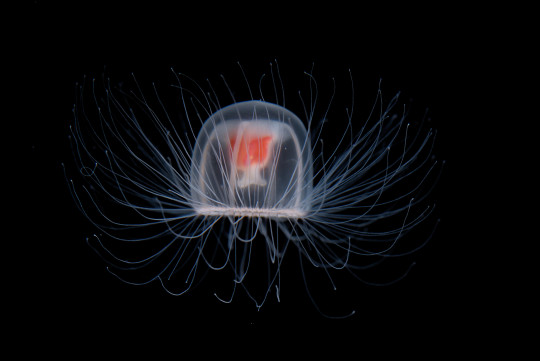
0 notes
Photo

This is the result of my friend asking me about the immortal jellyfish T. dohrnii. After the following nerd out, she drew Terry. I’m in love with it.
#this is precious#you can fight me on this#t. dohrnii AKA the immortal jellyfish#All Hail Terry#also look at her handwriting it’s amazing#ugh I love this so much
1 note
·
View note
Text
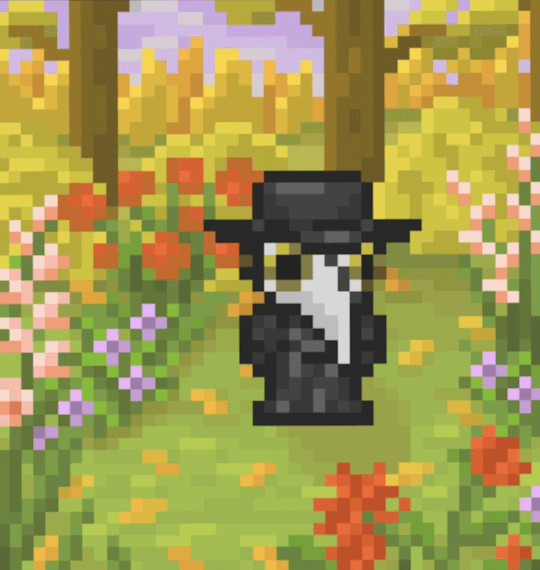
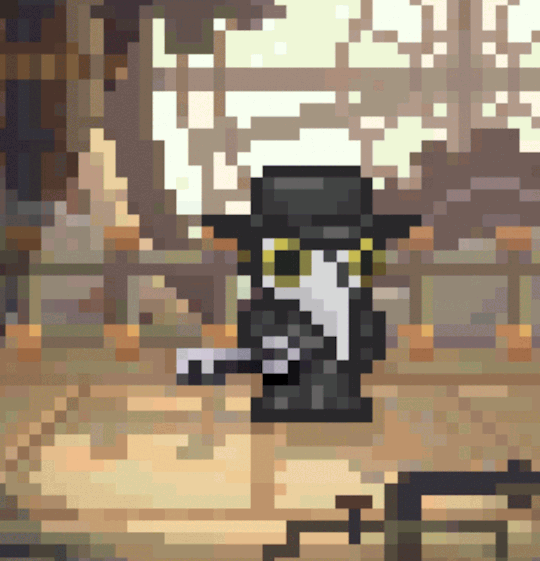
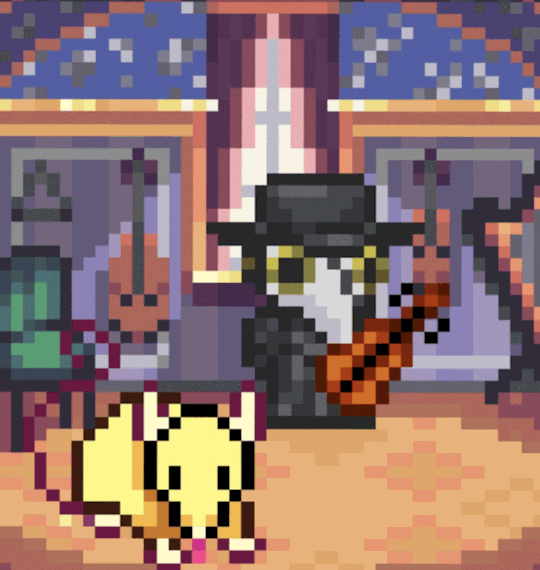
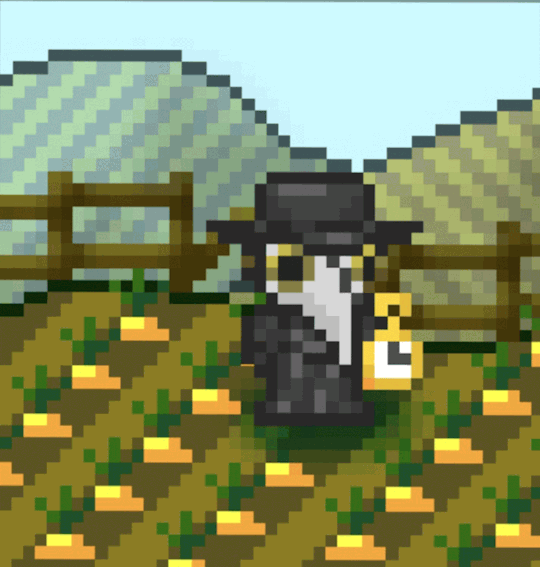
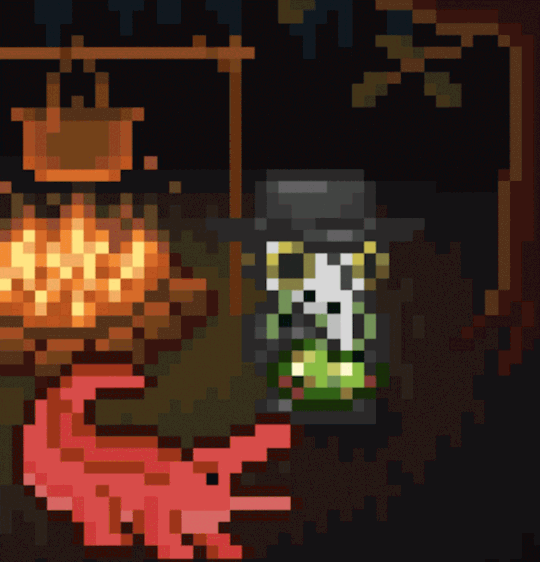
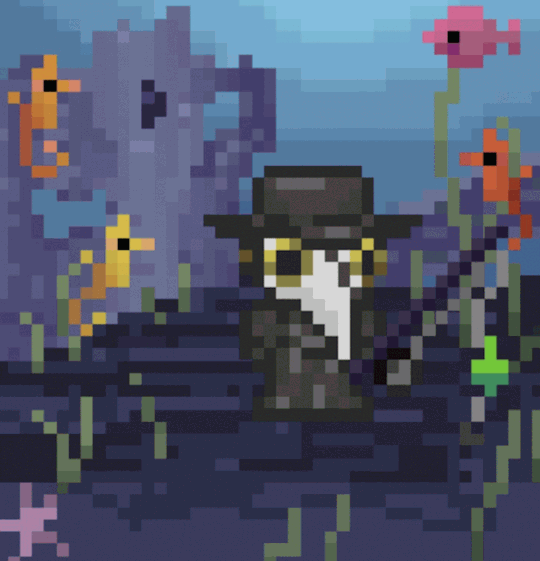
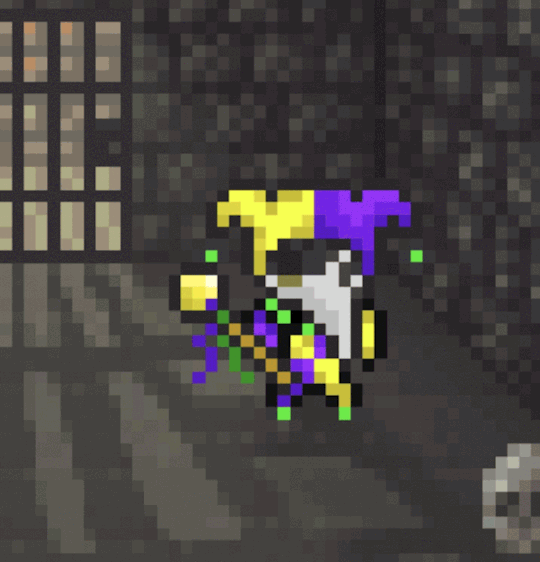
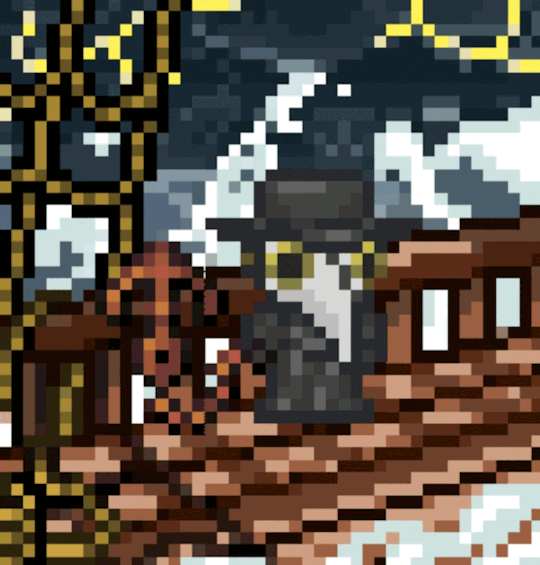
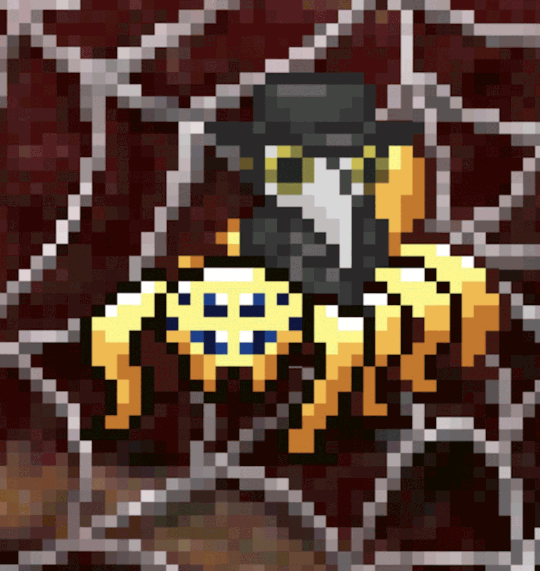
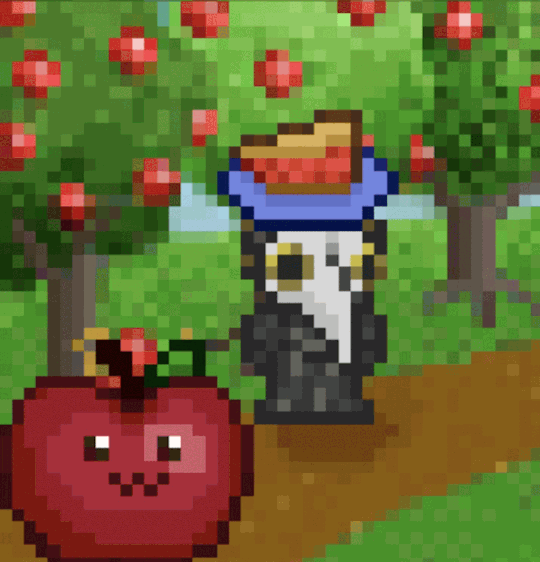
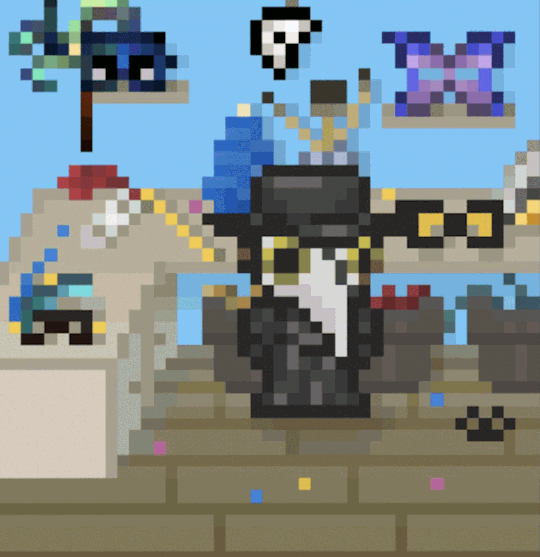
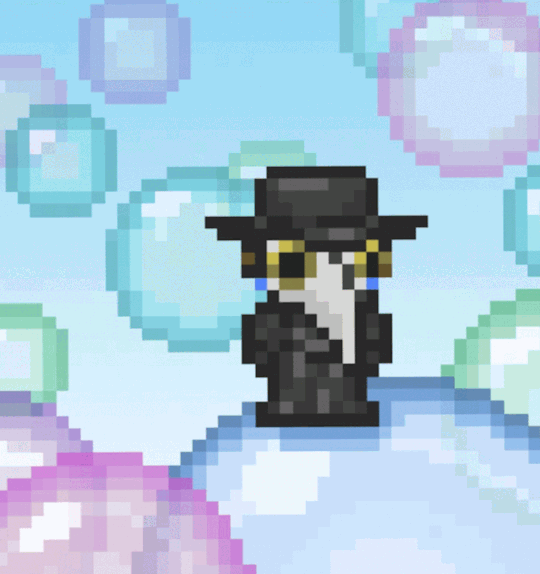
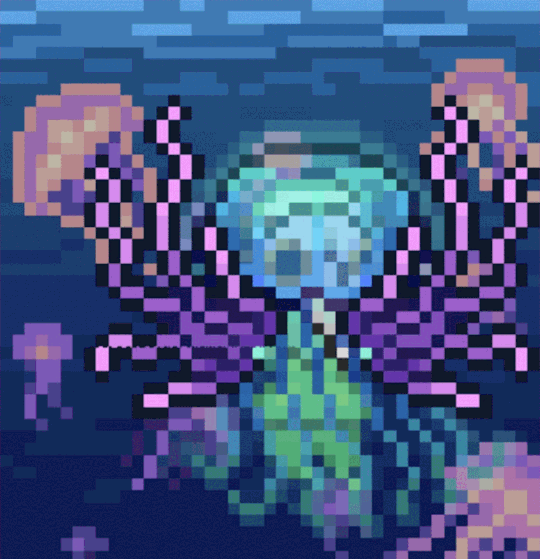
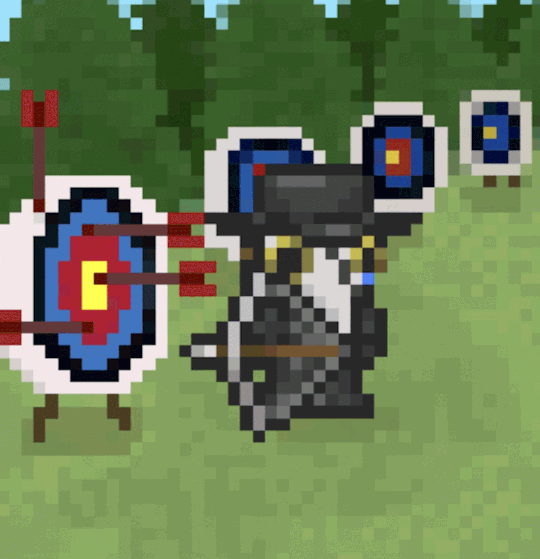
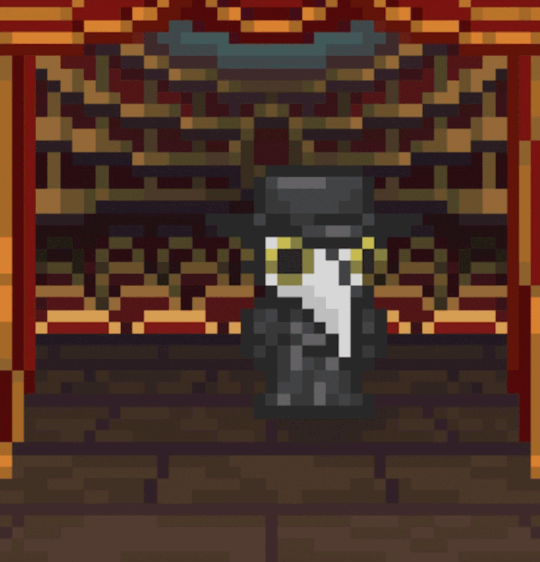
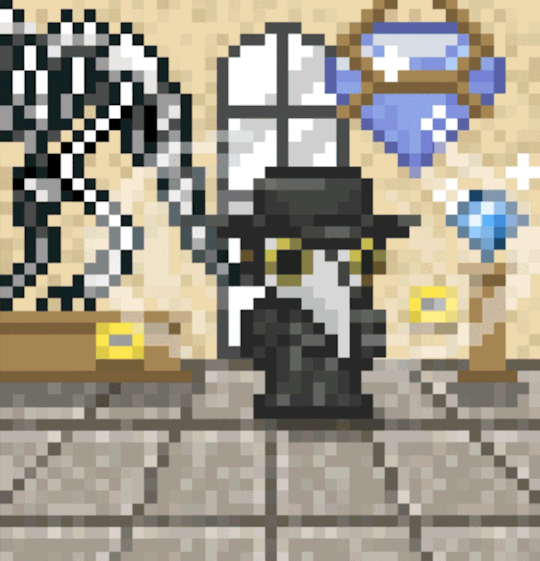
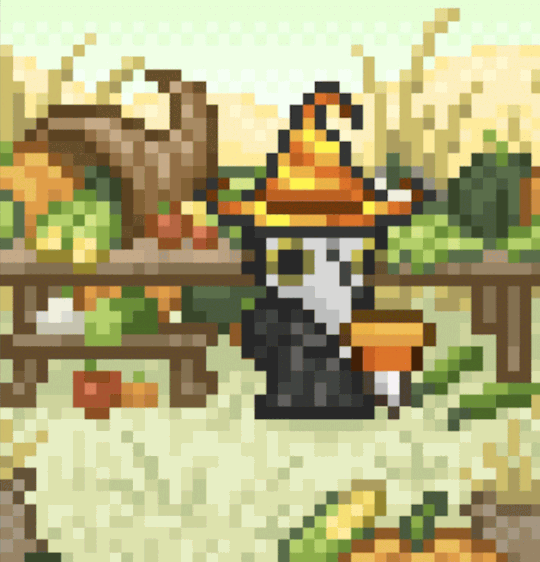
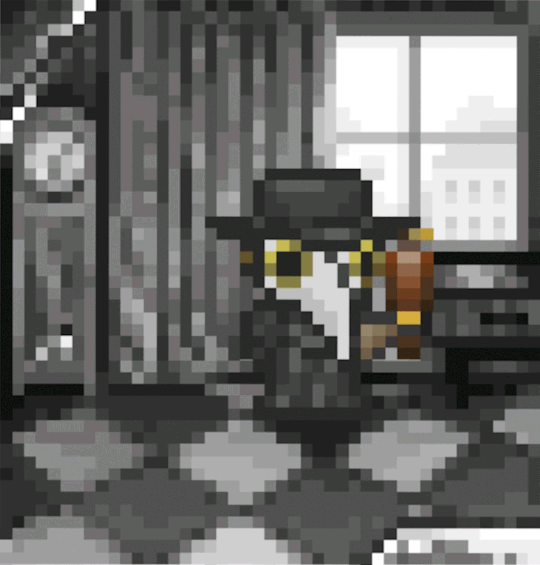
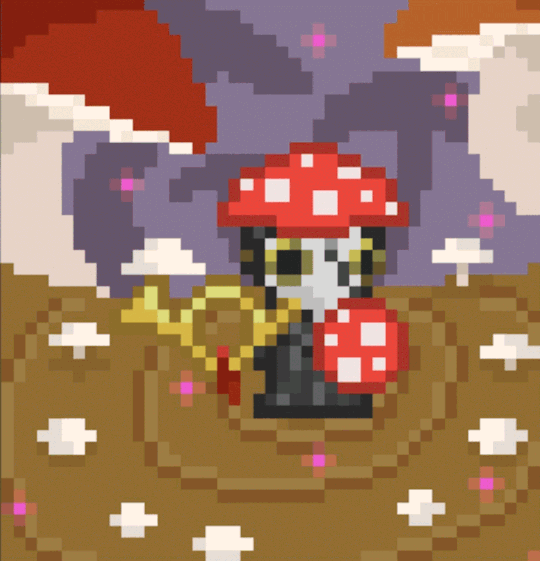
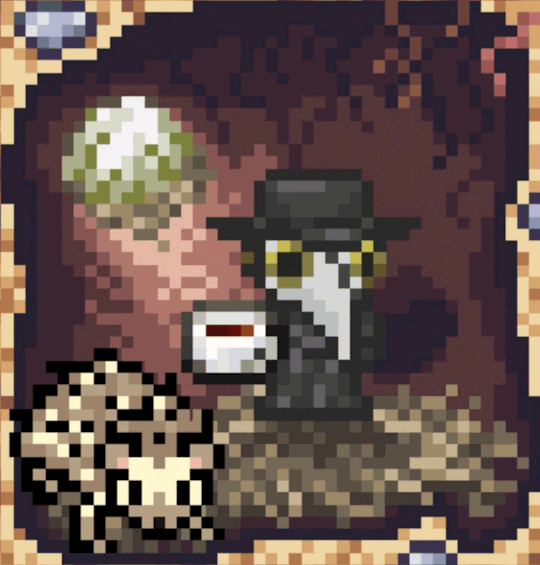
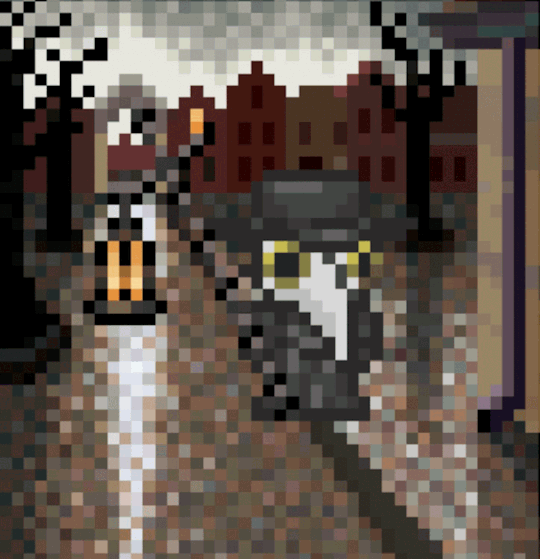
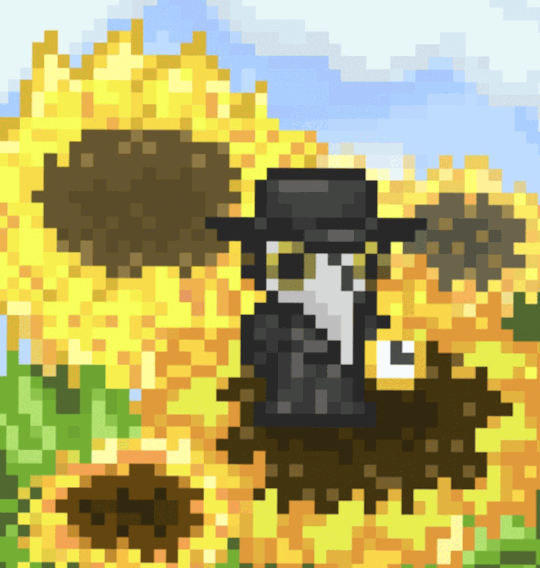
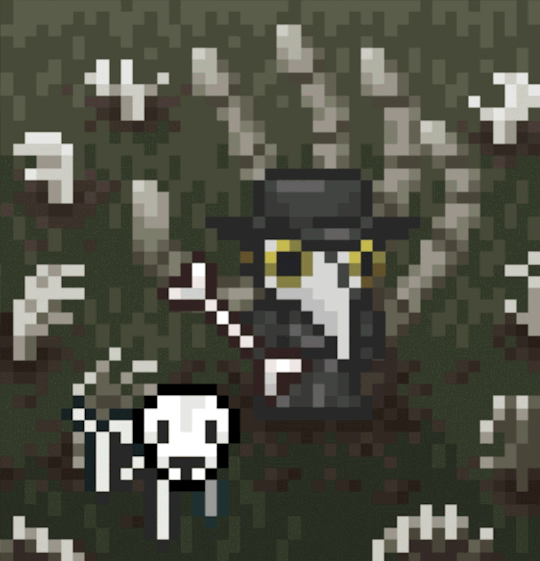
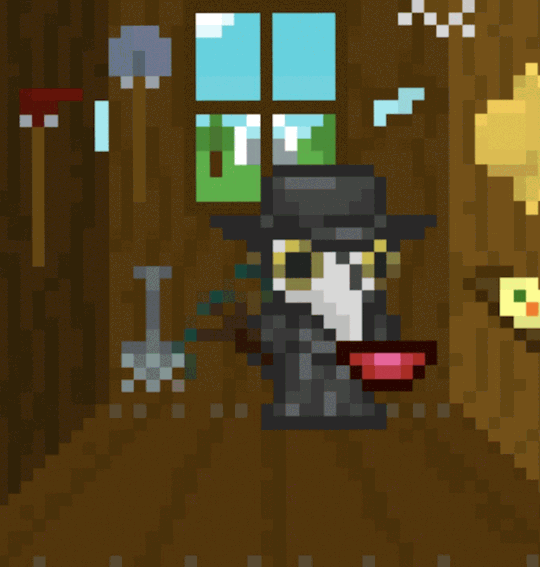
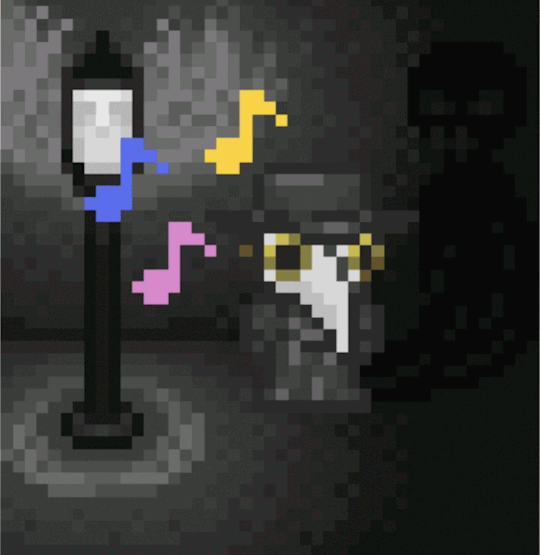
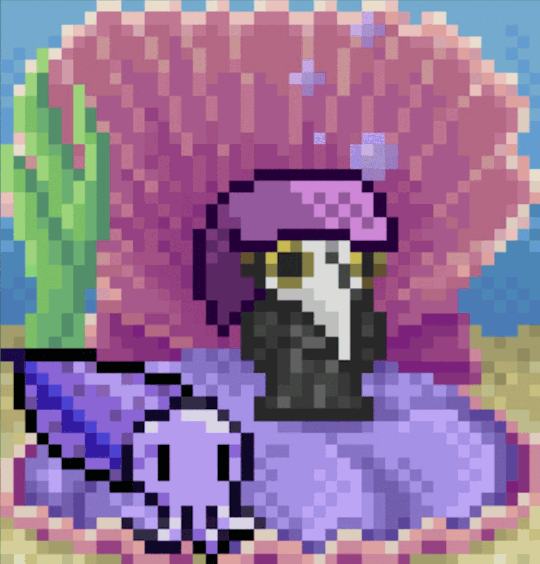


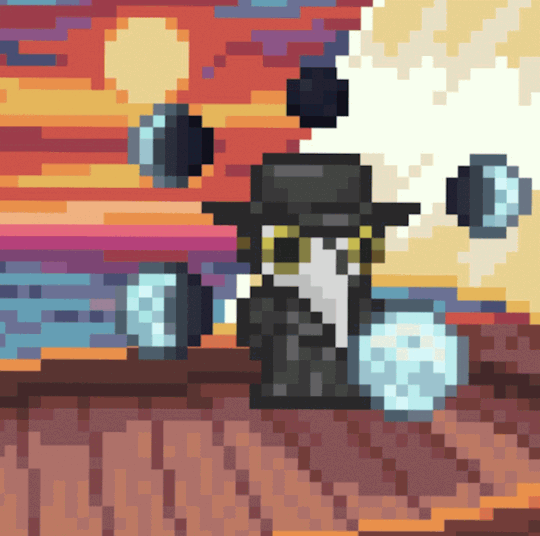
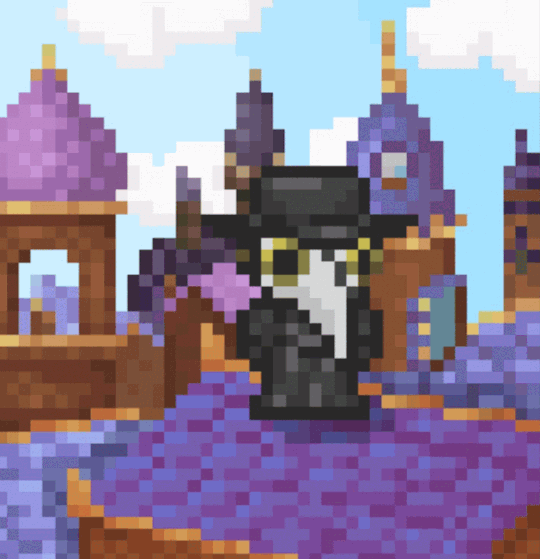
Plaguetober 2022 GIF roundup! Final GIF can be found here. (Have to link due to Tumblr image number restriction). Prompt list by the extremely excellent @plaguefairy. Captions below the readmore. (All credit to the original pixel art asset creators over at @habitica.)
Plaguetober Day 1: Garden -- Nothing could exceed the intentness with which this scientific gardener examined every shrub which grew in his path: it seemed as if he was looking into their inmost nature, making observations in regard to their creative essence, and discovering why one leaf grew in this shape and another in that, and wherefore such and such flowers differed among themselves in hue and perfume. Plaguetober Day 2: Key -- Dr Athanasius considered himself an unofficial steward of the old mechanism, though it involved a considerable climb, requiring much stealth, ever since he first obtained the key. Plaguetober Day 3: Familiar -- Whenever Dr Athanasius took up any of his instruments, Her Abdicated Former Majesty the Erstwhile Queen of Sweden (Erstwhile for short) was always sure to come running. Plaguetober Day 4: Clover -- This is number eight, and the doctor’s at the gate… Plaguetober Day 5: Rotten -- It might smell terrible to you, but it’s undeath-sustaining ambrosia to my hungry little friend here.
Plaguetober Day 6: Find -- After a bit of tricky fishing, he finally found it: The elusive Bone White Hippocamp! Her playful sea-horse woos her soft commands/Turns his quick ears, his webbed claws expands/His watery way with waving volutes wins/Or listening librates on unmoving fins. Plaguetober Day 7: Jester -- In prison cell and dungeon vile/Our thoughts to them are winging. When friends by shame are undefiled/How can I keep from singing? Plaguetober Day 8: Knot -- Now dash’d upon the billow/Our op'ning timbers creak/Each fears a wat'ry pillow/None stop the dreadful leak/To cling to slipp'ry shrouds/Each breathless seaman crowds/As she lay/Till the day/In the Bay of Biscay, O! Plaguetober Day 9: Conundrum -- When one finds oneself in a sticky situation, it can sometimes be advisable to transform one’s foe from an adversary to a steed. Plaguetober Day 10: Pie -- The venomous apples of the outer peninsula required some careful handling, but their flavor was truly beyond compare.
Plaguetober Day 11: Reveal -- I draw down/The open eye/That helped me see/Through the disguise. What’s concealed/Becomes revealed/And I am free.
Plaguetober Day 12: Circle -- Omnia nodis arcanis connexa quiescunt.
Plaguetober Day 13: Everlasting -- If the T. dohrnii jellyfish is exposed to environmental stress, physical assault, or is sick or old, it can revert to the polyp stage, forming a new polyp colony. It does this through the cell development process of transdifferentiation, which alters the differentiated state of the cells and transforms them into new types of cells. Theoretically, this process can go on indefinitely, effectively rendering the jellyfish biologically immortal.
Plaguetober Day 14: Impale -- In retrospect, perhaps Dr Athanasius should have ascertained that the range was clear before attempting to collect his arrows. Plaguetober Day 15: Play -- Govern these ventages with your fingers and thumb, give it breath with your mouth, and it will discourse most eloquent music. Plaguetober Day 16: Reminiscing -- Dr Athanasius in the Musaeum Kircherianum in Collegio Romano, the place of his creation, depicted next to the innermost segment of the speaking trumpet from which he had been lately disconnected. Plaguetober Day 17: Maize -- Dr Athanasius suddenly realized that he had gone all-in on precisely the wrong sort of corn for the Autumn Festival and strove quickly to obliterate the evidence of his faux pas. Plaguetober Day 18: Crime -- The cheaper the crook, the gaudier the patter. Plaguetober Day 19: Jovial -- Fly agaric didn’t tend to have quite the same effect on Dr Athanasius as it had on others of his acquaintance, but he enjoyed the occasional nibble just the same. Plaguetober Day 20: Awaken -- I was only wakened when I had reached the last light sleep which dissolves of itself, and it must have been very light, for it was an almost inaudible whistling noise that wakened me. Plaguetober Day 21: Chatter -- Ordinarily, Dr Athanasius thought of himself as a sort of elevated flaneur, creeping along the rooftops of the city, the chatter and hum of its citizens in his ears. But occasionally he walks the streets themselves, on those rare wet nights when the city is quite, quite empty and quite, quite still. Plaguetober Day 22: Lost -- Try as he might, Dr Athanasius could not reconstruct the plans for his Father’s sunflower clock. The secret to its mechanism seemed to have been forevermore lost. Plaguetober Day 23: Greet -- Dr Athanasius’s reanimated lion adored taking walkies in the Lichgate of the Belimbed, because there he always found a friendly hand to greet him, pat him, throw his bone, and offer him skeletal scritches. Plaguetober Day 24: Cobweb -- Once his friends the cobs were done with them, Dr Athanasius collected their webs for use in his armamentarium. They were particularly useful for staunching excessive bloodflow. Plaguetober Day 25: Melancholy -- Whenever Dr Athanasius felt a bit down, he pulled out his trusty copy of D'Urfey’s Pills to Purge Melancholy, and his heart was immediately lighter. Plaguetober Day 26: Rest -- You wouldn’t think a 17th Century automaton would dream, but you probably wouldn’t think a candle would stay lit in a giant clamshell either. Plaguetober Day 27: Sheet -- That old sheet that Dr Athanasius had stumbled across turned out to have some unexpected properties. Plaguetober Day 28: Cabinet -- Dr Athanasius inherited several things from his Father’s renowned Cabinet of Curiosities, among them the Ira Dei Dragon Balloon and the (slightly singed) Vesuvius Basket. Plaguetober Day 29: Embark -- Fortified by a draft of Cosmiel’s celestial liquor, Dr Athanasius prepares to essay the heavens. Plaguetober Day 30: Music -- Since his disconnection from his speaking trumpet, Dr Athanasius has lacked the power of speech, but from his perch atop the ramparts of the city, he strives always to embody the principles of the Musurgia Universalis. Plaguetober Day 31: Goodnight -- And so the Dr Athanasius who lives in dreams – perhaps only in dreams; perhaps not – bids farewell to him that has harbored him.
#plaguetober2022#plaguetober#plaguefairy#habitica#8-bit paper dolls#dr athanasius#kircher's automaton#plague doctor#plaguecore#plaguesona#plague doctor mask#kircher's automaton dreams 8-bit dreams
31 notes
·
View notes
Text
Immortality exists – but to get it, you need to be a jellyfish, not a god or a vampire. Moreover, only one species of cnidarian, Turritopsis dohrnii, is known to have found the secret of eternal life. Geneticists hope comparing T. dornii’s DNA with its close relative, T. rubra, will help us understand the aging process and how to evade it.
4 notes
·
View notes
Note
Btw, just had a small idea- I'd say it in the discord but I don't have discord lmao, but what if the principal was the typical really old guy and it was a t. dorhnii? So everyone says to not mess with them cause they have seen everything- literally lmao
I just really love the immortal jellyfish
Oooh that'd be a fun idea!
(Theoretical) Immortality in jellyfish is a VERRRRY neat concept. In scientific literature, it's usually referred to as "ontogeny reversal" (ie. Life Cycle reversal)- and it's actually been observed in a handful of other species as well! (with varying degrees of success).
We look to the Turritopsis dohrnii as the "immortal jellyfish" because either I think it was the first one we found to have the trait, or because it was the one with the most reliable ontogeny reversal (other species of the Turritopsis genus are capable of the phenomenon, but the T. dorhnii was able to do it with a higher rate of success)
Anyway, I'd be damned if I went through this game without exploring the concept of reverse ontogeny at least once, hehe.
#gAH I CAN'T SAY TOO MUCH WITHOUT SPOILING SO I HOPE YOU'LL FORGIVE ME FOR DANCING AROUND THE TOPIC#just know that a lot of other jellies are capable of reverse ontogeny but only in the early stages of their life#anyway#yea#lmao#jellyfish#mun rambles#this concept is so cute tho i love it#ask
7 notes
·
View notes
Note
Thank you for answering my ask. You talk about how faunus would be exploited for "medical miracles" and I thought of one particularly insane scenario. Tell me how crazy do you think the mega rich and the scientific community would get over a faunus with biological immortality of the Turritopsis dohrnii AKA immortal jellyfish? We have an individual who returns to a younger state when old, severely injured or sick and could potentially live forever as long as they are not outright killed.
You’re quite welcome!
A Faunus based on T. dohrynii is what I would call theoretically interesting, in that it hinges on whether or not it’s possible under the constraints of RWBY’s lore.
And that, in turn, depends on the degree to which RWBY is married to realism.
Wall of text inbound, because I am a massive nerd.
Jellyfish are, in a manner of speaking, simple organisms when compared to other animals. Cnidarians are the sister clade to bilaterians (all animals with bilateral symmetry), which makes them one of the oldest lineages of metazoans on the planet, excluding ctenophores (comb jellies), protozoans, and poriferans (sponges). Their bodies are a hydrostatic skeleton composed of mesoglea, a transparent jelly-like tissue. More than 95% of their mesoglea is water. They lack specialized systems for respiration and circulation—oxygen literally diffuses from the water right into their bodies. They have a single opening that directly allows food and waste to pass through their gastrovascular cavity, effectively making this opening both a mouth and an anus.
The reason why I mention any of this is because I’m not sure it would even be possible for a jellyfish Faunus to exist, let alone do something like transdifferentiation.
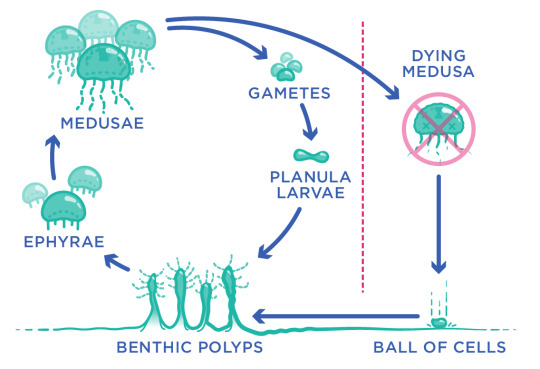
The lifecycle of T. dohrynii, as it depicts transdifferentiation. | Source: The Australian Academy of Science.
In the case of T. dohrynii, “immortality” is a bit of a misnomer, because these jellyfish can die to predation. What actually happens is that the jellyfish, when exposed to environmental stress, physical assault, old age, or sickness, can revert back to the polyp stage. It does this through a process called transdifferentiation, in which mature, differentiated cells can transform into a different type of mature, differentiated cell, without first having to return to an immature pluripotent state.
I have to wonder if the reason why this trait is so rare in nature is because it requires the organism to be so simple in the first place. Would an animal as complex as a hominid—a triploblastic vertebrate with over 200 types of differentiated, specialized cells—be able to pull this off without that degree of simplicity?
Given that Faunus are, for all intents and purposes, hominids, would their primate biology be able to even handle that sort of radical alteration? How would that work on an animal whose body is only comprised of 60% water, with the other 40% being organic matter and acellular materials?
Again, this is where “how much does realism matter to your story” comes into play. So: could a Faunus based on an immortal jellyfish exist?
The answer is yes, absolutely—provided your audience is willing to suspend their disbelief, and your story leans more heavily on fantasy than science fiction.
(In which case, yeah, I can picture the sort of scenarios that a Faunus with that trait would be dealing with. And they wouldn’t be pretty. If they’re smart though, they would try to pass themself off as human, or lie about what their trait is, in order to avoid drawing the attention of the medical community. Otherwise, they’d be getting harassed to participate in academic studies. And for the record, that’s the best case scenario.)
#asks#hivemind42#faunus#i speak#for the record the redux isn't going to have any faunus with cnidarian characteristics#but oh my god could you imagine the poor bastard who has this trait#every bio lab on remnant with grant money would have this dude's address and phone number#they'd be constantly sending letters or leaving voicemails to try and convince them to participate in their studies#hey come volunteer for our ethically-dubious clinical trials#just sign right here#don't worry you don't need to read over the other 102 pages#that's just legal nonsense#definitely not you signing away the rights to your organs#biology
2 notes
·
View notes